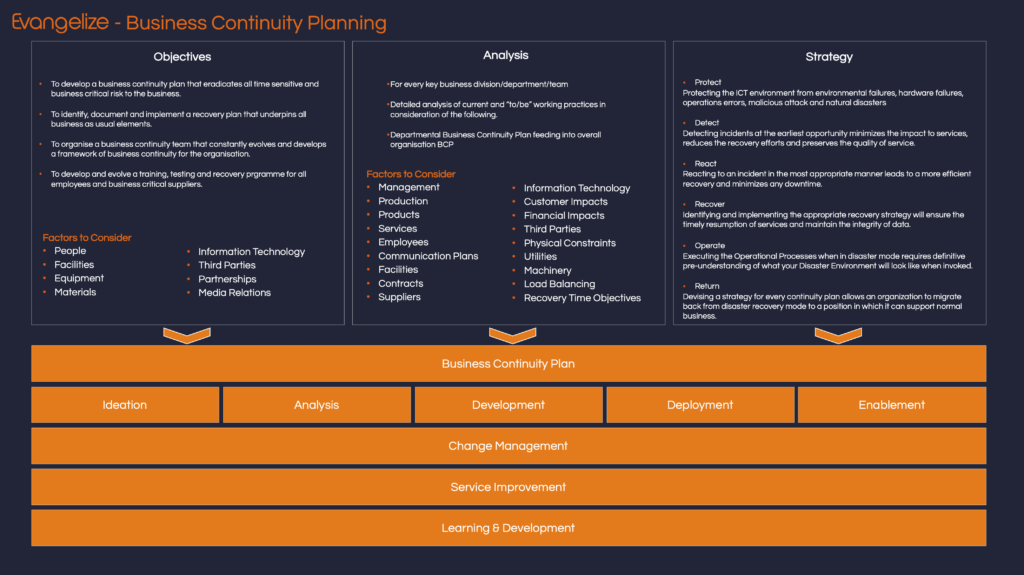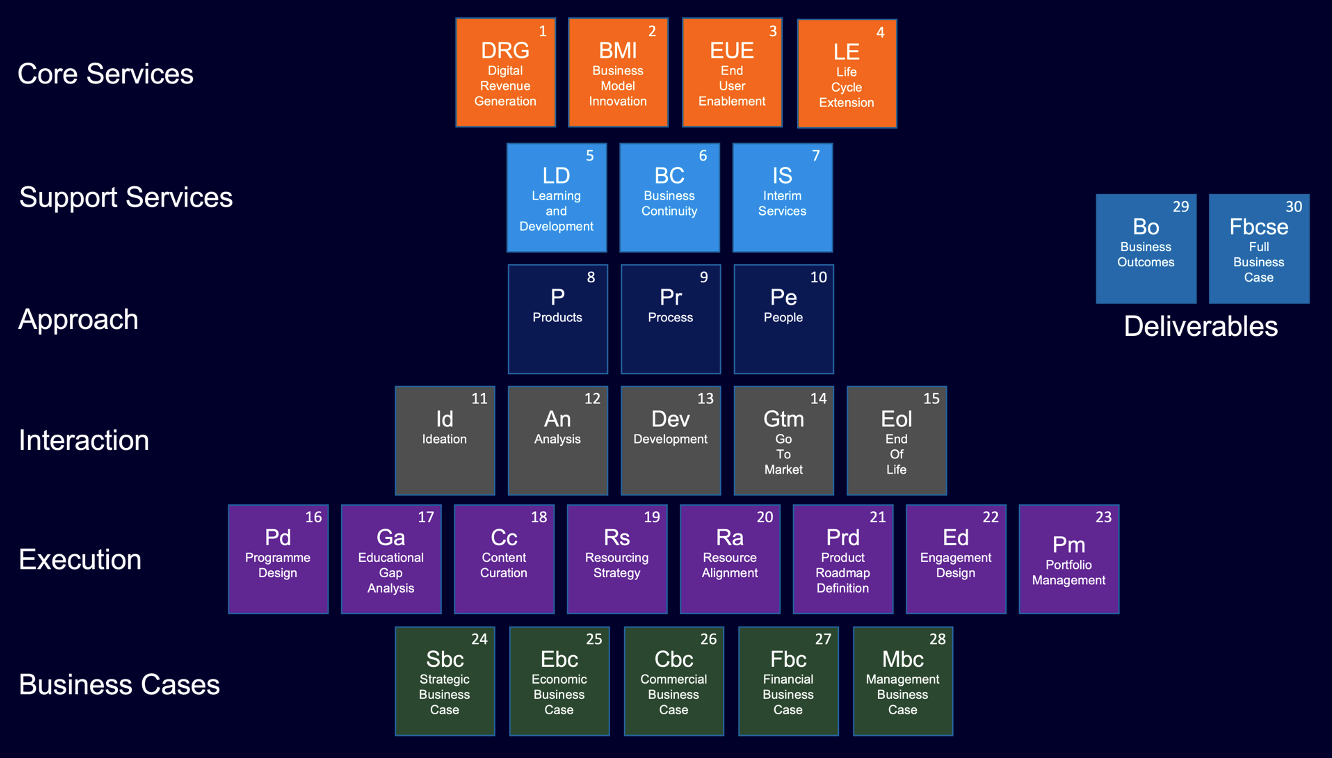Business Model Innovation
Evangelize has over 70 business models from which to utilise within your organisation.
Business model innovation involves creating, adopting, or modifying business models to better serve consumers and stakeholders and expand sustainably and profitably. This method entails questioning corporate assumptions and finding new ways to deliver customer technology value.
Business model innovation could involve new products, services, distribution methods, revenue models, partnerships, and ecosystems.
Business Model Innovation
- Businesses must innovate business models to increase revenue, minimise expenses, and improve efficiency. By adopting customer-centric business strategies and anticipating market changes, firms can increase value and revenue. Business model innovation helps organisations identify and eliminate operational inefficiencies, lowering expenses.
- When used with Business Continuity Planning (BCP), efficient processes and modern technologies are essential for boosting organisational resilience and agility.
- Optimising operational workflows and integrating advanced technologies can help businesses minimise downtime and enhance response times during disruptions.
- Cloud computing allows for data and applications to be accessed from anywhere, ensuring business functions stay operational even during office closures.
- Automation and AI enable quick decision-making and resource allocation, reducing the impact of unexpected events. These improvements not only strengthen our business continuity strategy, but also boost efficiency, profitability, and our competitive edge.
By strategically investing in these areas, companies can stay ahead of threats, quickly adapt to changes, and keep their operations running smoothly. This will protect their market position and guarantee long-term success.

Key aspects of business model innovation include:
-
Value Proposition Innovation: At the heart of business model innovation is reimagining the value a company offers to its customers. This could involve creating new products or services that meet emerging needs or repositioning existing offerings uniquely. For example, a company might shift from selling physical products to offering digital solutions, thereby changing its value proposition.
-
Customer-Centric Focus: Business model innovation often starts with deeply understanding customer needs and behaviours. Companies may use customer feedback, data analytics, and market research to identify pain points and unmet demands, which can lead to developing customer-centric business models.
-
Distribution and Channel Innovation: Businesses can innovate by exploring new distribution channels or optimising existing ones. For instance, a traditional brick-and-mortar retailer might expand into e-commerce or explore partnerships with online marketplaces to reach a broader audience.
-
Revenue Model Innovation: Innovating how a company generates revenue can be transformative. Subscription-based models, tiered pricing, or freemium approaches can all be part of revenue model innovation. The goal is to find pricing strategies that align with the perceived value of the product or service.
-
Cost Structure Optimisation: Achieving operational efficiencies and cost savings is another facet of business model innovation. Companies can explore ways to reduce overhead, streamline processes, or leverage outsourcing to lower costs while maintaining quality.
-
Ecosystem and Partner Collaboration: Collaborations and partnerships can be instrumental in business model innovation. Companies may form strategic alliances or participate in industry ecosystems to access new markets, technologies, or resources.
-
Technological Integration: Technology plays a significant role in modern business model innovation. Companies often leverage digital technologies, automation, artificial intelligence, and data analytics to enhance their operations, improve customer experiences, and create new digital revenue streams.
-
Sustainability and Social Responsibility: In recent years, sustainability and social responsibility have become critical components of business model innovation. Companies are incorporating environmentally friendly practices, ethical sourcing, and corporate social responsibility into their models to appeal to socially conscious consumers.
-
Iterative Process: Business model innovation is rarely a one-time effort. It often involves an iterative process of experimentation, feedback, and adaptation. Companies must be agile and willing to pivot if their initial innovations don’t yield the desired results.
-
Competitive Advantage: Successful business model innovation should lead to a sustainable competitive advantage. It allows companies to differentiate themselves, respond to market changes, and stay ahead of competitors.
Instead of solely focusing on developing different features of the product, the ten types of innovation-framework approaches innovation in a more holistic way, claiming that the best results can be achieved when all of the following categories are considered.

The three main categories of this model are:
Configuration
Comprises your profit model, networks, structures and processes. In other words, your business model.
Offering
The offering-category includes distinguishing features and functionalities as well as complimentary products and services related to your system, referred to as your technology.
Experience
The experience, consists of all the channels through which your offerings are delivered to your customers and users, as well as your brand, service and other distinctive interactions with your customers, also known as your marketing.
Business model innovation is essential in today’s rapidly changing business landscape, where disruptive technologies and evolving customer preferences can quickly render existing models obsolete.
Companies that successfully innovate their business models can adapt to these changes and find new avenues for growth and competitiveness.
How Evangelize implements Business Model Innovation to define the ultimate Go To Market Strategy
A strategic and holistic approach is paramount to successfully implementing business model innovation within an organisation. It begins with thoroughly examining the core services and heart of the business. Identify the existing offerings and assess their relevance in the evolving market landscape. Simultaneously, evaluate support services, which are the backbone of operations. Ensure they align with the new model and provide the necessary infrastructure for innovation.
The approach to business model innovation must be collaborative and inclusive. Engage cross-functional teams and solicit input from employees at all levels. Foster a culture of innovation where ideas flow freely and are systematically evaluated. Encourage interaction among team members, enabling them to share insights and expertise. This collaborative effort will unearth fresh perspectives and potential avenues for transformation.
Execution is where the rubber meets the road. Develop a clear roadmap for implementing the new business model. Assign responsibilities, set timelines, and establish key performance indicators (KPIs) to track progress. Emphasise the importance of agile adaptation-be prepared to pivot if necessary. Furthermore, construct compelling business cases highlighting the proposed model’s benefits and potential ROI. These cases should outline the value proposition, anticipated cost savings, revenue potential, and market impact.
Implementing business model innovation is a multidimensional effort encompassing core and support services, an inclusive approach, robust interaction, agile execution, and persuasive business cases. By carefully orchestrating these elements, organisations can embrace innovation as a driver of growth and resilience in today’s dynamic business environment.

Business Case Facts
-
- A study by McKinsey & Company found that companies that actively pursue business model innovation can expect to generate up to 20-30% higher profit margins than companies that do not.
- Additionally, a study by the MIT Sloan Management Review found that companies that focus on customer-centric business models can outperform their peers by up to 60% in terms of both revenue growth and profitability.
- According to objective worldwide research, the business case was the most significant value destroyer.
- If a project has the wrong scope, poor requirements, and the wrong target, its business case will not maximise the project’s value.
- If appropriately used, business cases will help cut costs and improve project outcomes. More importantly, the guidance will help anyone involved with or overseeing a project understand the work necessary to prove an investment case. This will enable a business case to become what it should be – not a bureaucratic necessity to obtain approvals, but a document demonstrating evidence-based decision-making.
- The percentage of projects that fail is legendary. Like all good legends, the details vary, but depending on which research you consult, the failure rate can be as little as 20% and as high as 80%.
- Gartner’s studies suggest that 75% of projects are considered failures by those responsible for initiating them. But what do they mean by failure? They represent the solutions fundamentally did not do what was agreed. Or they missed deadlines and/or came in over budget.
- Indeed, half of the projects exceeded budget by 200%! A Standish Group study found that 31% of projects were cancelled outright and that the performance of 53% of all projects was so worrying that they were challenged.
Some questions that need to be answered in assessing whether a project is fundamentally a success or failure:
Has the project satisfied the business requirements of the primary stakeholders?
Were the deliverables produced on time and within budget (or as amended by agreed change control)?
Do the business owners perceive the project to be successful?
Has the project delivered the business value promised in the original business case?
